Substance Use and Society: An Analysis of Drug Consumption
VerifiedAdded on 2023/01/12
|9
|3080
|72
Essay
AI Summary
This essay provides an analysis of substance use and its impact on society, examining the reasons why individuals turn to drugs, the correlation between drug use and crime, and different types of drug interventions. It discusses how factors such as social norms, coping mechanisms, and the desire for experimentation contribute to drug consumption, particularly among young people. The essay also explores the connection between drug dependency and acquisitive crimes, while highlighting that pre-existing factors like poverty and social exclusion often underlie both drug use and criminal behavior. Furthermore, it analyses the stimulants drug type and the impact of drugs on individuals' mental and physical well-being, emphasizing the importance of understanding the facts about drugs and seeking help to address addiction. The document is available on Desklib, a platform offering a wide range of study resources for students.
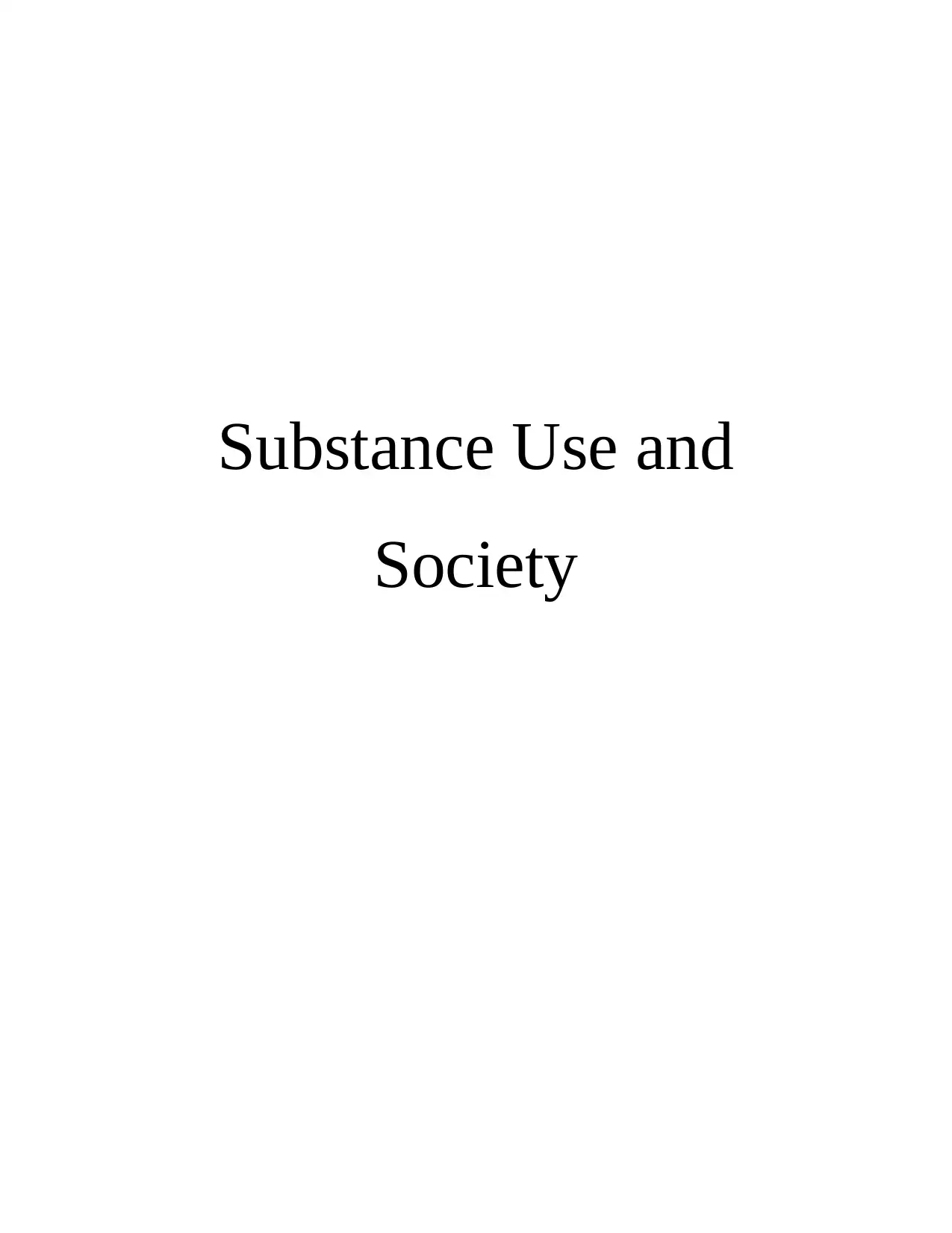
Substance Use and
Society
Society
Paraphrase This Document
Need a fresh take? Get an instant paraphrase of this document with our AI Paraphraser
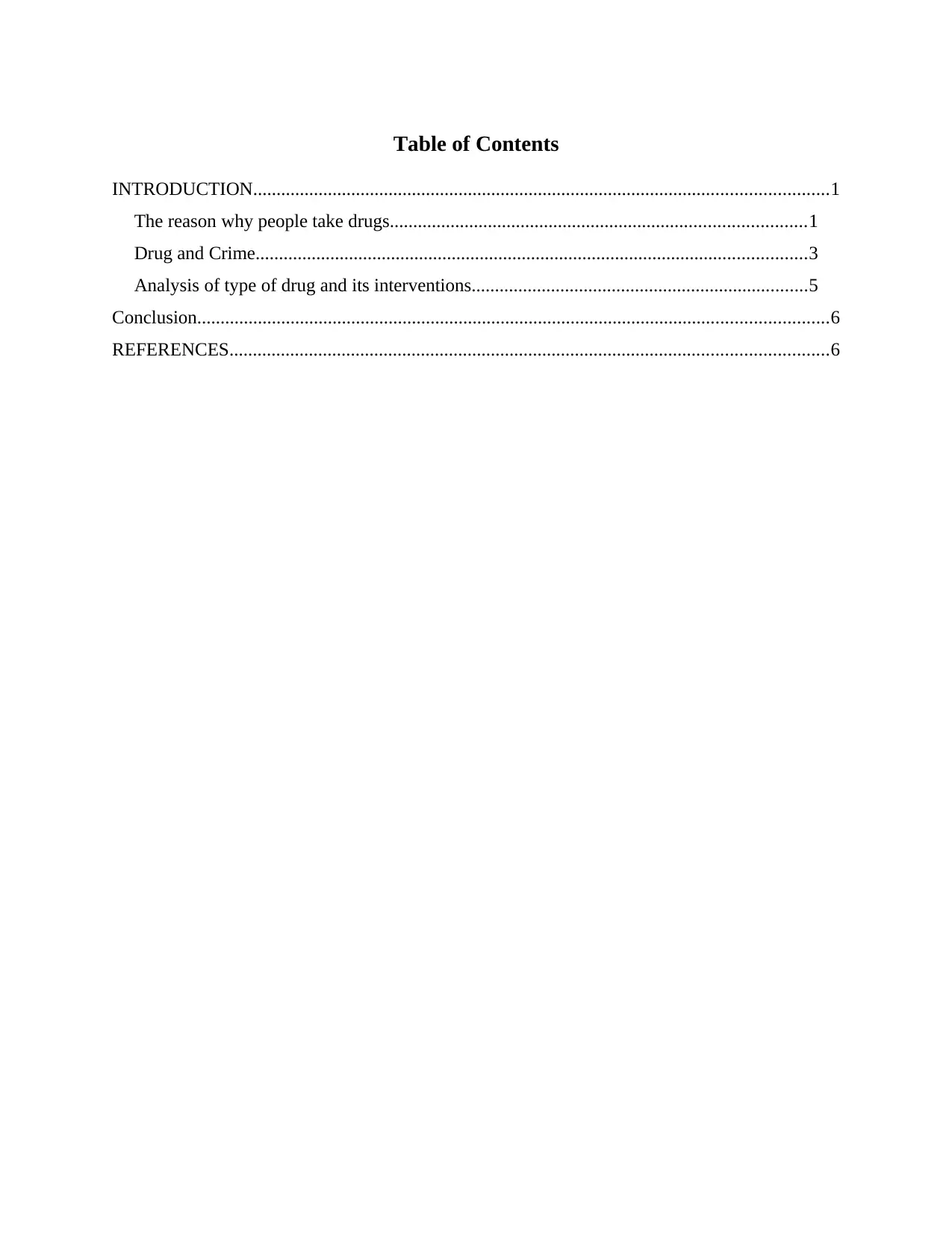
Table of Contents
INTRODUCTION...........................................................................................................................1
The reason why people take drugs.........................................................................................1
Drug and Crime......................................................................................................................3
Analysis of type of drug and its interventions........................................................................5
Conclusion.......................................................................................................................................6
REFERENCES................................................................................................................................6
INTRODUCTION...........................................................................................................................1
The reason why people take drugs.........................................................................................1
Drug and Crime......................................................................................................................3
Analysis of type of drug and its interventions........................................................................5
Conclusion.......................................................................................................................................6
REFERENCES................................................................................................................................6
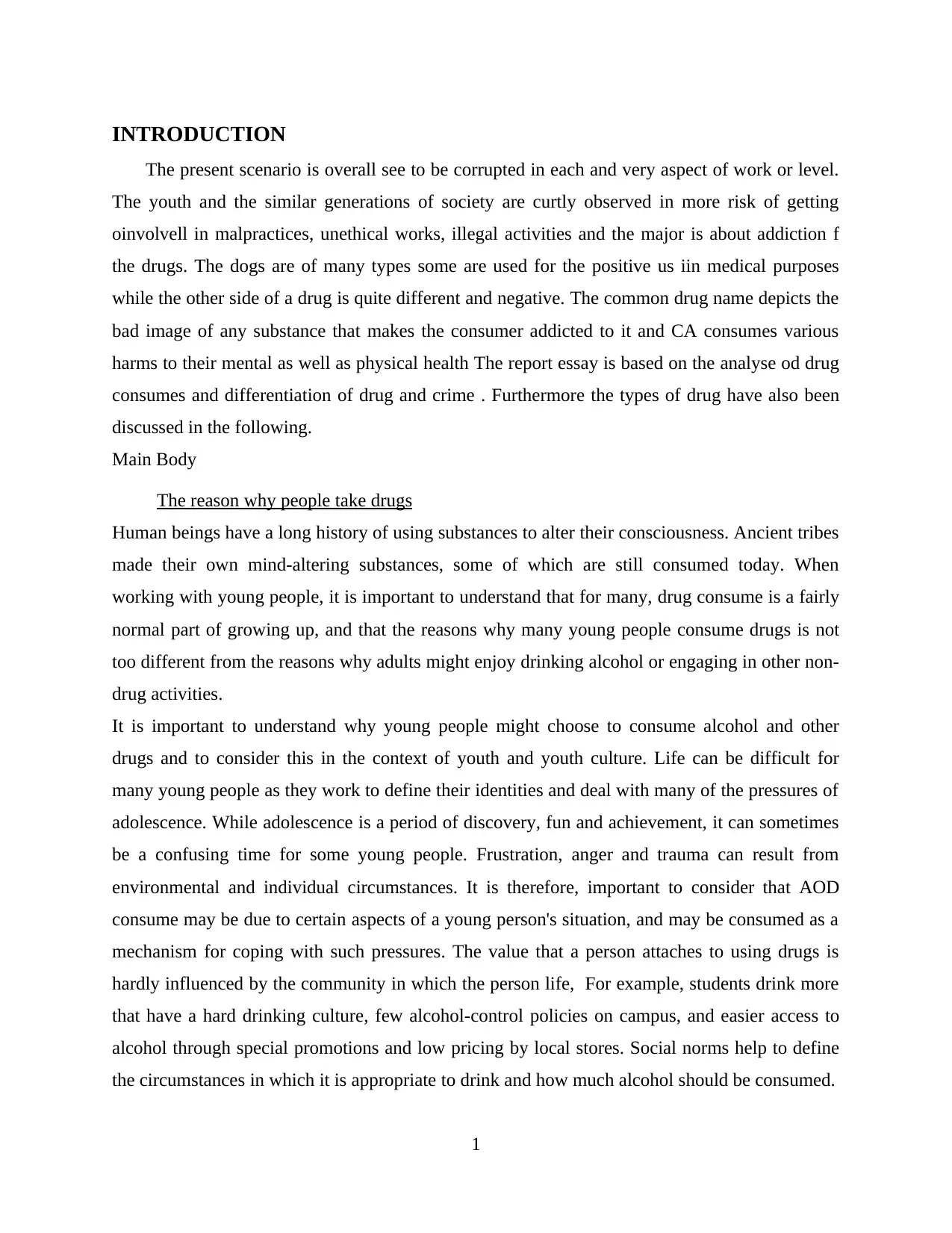
INTRODUCTION
The present scenario is overall see to be corrupted in each and very aspect of work or level.
The youth and the similar generations of society are curtly observed in more risk of getting
oinvolvell in malpractices, unethical works, illegal activities and the major is about addiction f
the drugs. The dogs are of many types some are used for the positive us iin medical purposes
while the other side of a drug is quite different and negative. The common drug name depicts the
bad image of any substance that makes the consumer addicted to it and CA consumes various
harms to their mental as well as physical health The report essay is based on the analyse od drug
consumes and differentiation of drug and crime . Furthermore the types of drug have also been
discussed in the following.
Main Body
The reason why people take drugs
Human beings have a long history of using substances to alter their consciousness. Ancient tribes
made their own mind-altering substances, some of which are still consumed today. When
working with young people, it is important to understand that for many, drug consume is a fairly
normal part of growing up, and that the reasons why many young people consume drugs is not
too different from the reasons why adults might enjoy drinking alcohol or engaging in other non-
drug activities.
It is important to understand why young people might choose to consume alcohol and other
drugs and to consider this in the context of youth and youth culture. Life can be difficult for
many young people as they work to define their identities and deal with many of the pressures of
adolescence. While adolescence is a period of discovery, fun and achievement, it can sometimes
be a confusing time for some young people. Frustration, anger and trauma can result from
environmental and individual circumstances. It is therefore, important to consider that AOD
consume may be due to certain aspects of a young person's situation, and may be consumed as a
mechanism for coping with such pressures. The value that a person attaches to using drugs is
hardly influenced by the community in which the person life, For example, students drink more
that have a hard drinking culture, few alcohol-control policies on campus, and easier access to
alcohol through special promotions and low pricing by local stores. Social norms help to define
the circumstances in which it is appropriate to drink and how much alcohol should be consumed.
1
The present scenario is overall see to be corrupted in each and very aspect of work or level.
The youth and the similar generations of society are curtly observed in more risk of getting
oinvolvell in malpractices, unethical works, illegal activities and the major is about addiction f
the drugs. The dogs are of many types some are used for the positive us iin medical purposes
while the other side of a drug is quite different and negative. The common drug name depicts the
bad image of any substance that makes the consumer addicted to it and CA consumes various
harms to their mental as well as physical health The report essay is based on the analyse od drug
consumes and differentiation of drug and crime . Furthermore the types of drug have also been
discussed in the following.
Main Body
The reason why people take drugs
Human beings have a long history of using substances to alter their consciousness. Ancient tribes
made their own mind-altering substances, some of which are still consumed today. When
working with young people, it is important to understand that for many, drug consume is a fairly
normal part of growing up, and that the reasons why many young people consume drugs is not
too different from the reasons why adults might enjoy drinking alcohol or engaging in other non-
drug activities.
It is important to understand why young people might choose to consume alcohol and other
drugs and to consider this in the context of youth and youth culture. Life can be difficult for
many young people as they work to define their identities and deal with many of the pressures of
adolescence. While adolescence is a period of discovery, fun and achievement, it can sometimes
be a confusing time for some young people. Frustration, anger and trauma can result from
environmental and individual circumstances. It is therefore, important to consider that AOD
consume may be due to certain aspects of a young person's situation, and may be consumed as a
mechanism for coping with such pressures. The value that a person attaches to using drugs is
hardly influenced by the community in which the person life, For example, students drink more
that have a hard drinking culture, few alcohol-control policies on campus, and easier access to
alcohol through special promotions and low pricing by local stores. Social norms help to define
the circumstances in which it is appropriate to drink and how much alcohol should be consumed.
1
⊘ This is a preview!⊘
Do you want full access?
Subscribe today to unlock all pages.

Trusted by 1+ million students worldwide
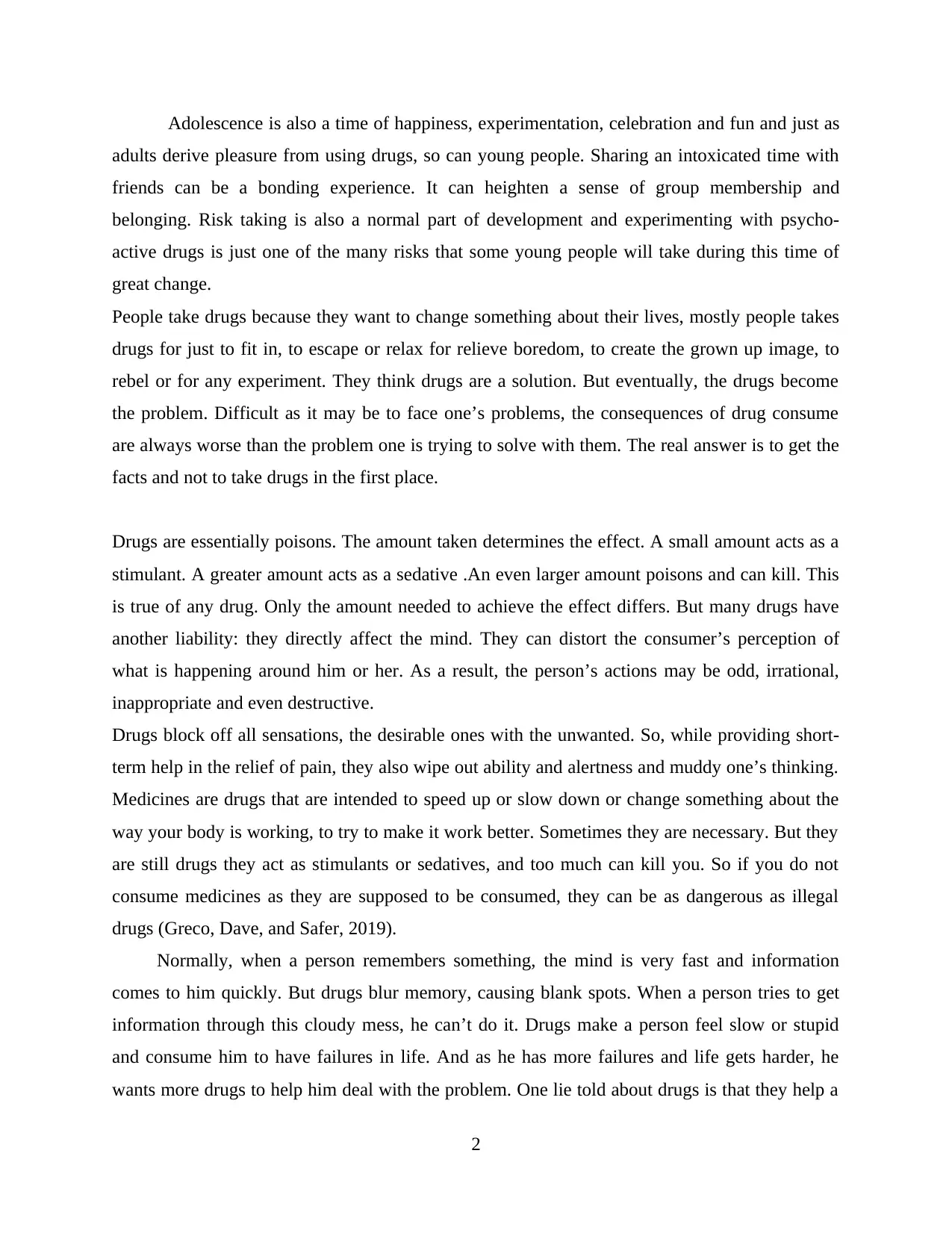
Adolescence is also a time of happiness, experimentation, celebration and fun and just as
adults derive pleasure from using drugs, so can young people. Sharing an intoxicated time with
friends can be a bonding experience. It can heighten a sense of group membership and
belonging. Risk taking is also a normal part of development and experimenting with psycho-
active drugs is just one of the many risks that some young people will take during this time of
great change.
People take drugs because they want to change something about their lives, mostly people takes
drugs for just to fit in, to escape or relax for relieve boredom, to create the grown up image, to
rebel or for any experiment. They think drugs are a solution. But eventually, the drugs become
the problem. Difficult as it may be to face one’s problems, the consequences of drug consume
are always worse than the problem one is trying to solve with them. The real answer is to get the
facts and not to take drugs in the first place.
Drugs are essentially poisons. The amount taken determines the effect. A small amount acts as a
stimulant. A greater amount acts as a sedative .An even larger amount poisons and can kill. This
is true of any drug. Only the amount needed to achieve the effect differs. But many drugs have
another liability: they directly affect the mind. They can distort the consumer’s perception of
what is happening around him or her. As a result, the person’s actions may be odd, irrational,
inappropriate and even destructive.
Drugs block off all sensations, the desirable ones with the unwanted. So, while providing short-
term help in the relief of pain, they also wipe out ability and alertness and muddy one’s thinking.
Medicines are drugs that are intended to speed up or slow down or change something about the
way your body is working, to try to make it work better. Sometimes they are necessary. But they
are still drugs they act as stimulants or sedatives, and too much can kill you. So if you do not
consume medicines as they are supposed to be consumed, they can be as dangerous as illegal
drugs (Greco, Dave, and Safer, 2019).
Normally, when a person remembers something, the mind is very fast and information
comes to him quickly. But drugs blur memory, causing blank spots. When a person tries to get
information through this cloudy mess, he can’t do it. Drugs make a person feel slow or stupid
and consume him to have failures in life. And as he has more failures and life gets harder, he
wants more drugs to help him deal with the problem. One lie told about drugs is that they help a
2
adults derive pleasure from using drugs, so can young people. Sharing an intoxicated time with
friends can be a bonding experience. It can heighten a sense of group membership and
belonging. Risk taking is also a normal part of development and experimenting with psycho-
active drugs is just one of the many risks that some young people will take during this time of
great change.
People take drugs because they want to change something about their lives, mostly people takes
drugs for just to fit in, to escape or relax for relieve boredom, to create the grown up image, to
rebel or for any experiment. They think drugs are a solution. But eventually, the drugs become
the problem. Difficult as it may be to face one’s problems, the consequences of drug consume
are always worse than the problem one is trying to solve with them. The real answer is to get the
facts and not to take drugs in the first place.
Drugs are essentially poisons. The amount taken determines the effect. A small amount acts as a
stimulant. A greater amount acts as a sedative .An even larger amount poisons and can kill. This
is true of any drug. Only the amount needed to achieve the effect differs. But many drugs have
another liability: they directly affect the mind. They can distort the consumer’s perception of
what is happening around him or her. As a result, the person’s actions may be odd, irrational,
inappropriate and even destructive.
Drugs block off all sensations, the desirable ones with the unwanted. So, while providing short-
term help in the relief of pain, they also wipe out ability and alertness and muddy one’s thinking.
Medicines are drugs that are intended to speed up or slow down or change something about the
way your body is working, to try to make it work better. Sometimes they are necessary. But they
are still drugs they act as stimulants or sedatives, and too much can kill you. So if you do not
consume medicines as they are supposed to be consumed, they can be as dangerous as illegal
drugs (Greco, Dave, and Safer, 2019).
Normally, when a person remembers something, the mind is very fast and information
comes to him quickly. But drugs blur memory, causing blank spots. When a person tries to get
information through this cloudy mess, he can’t do it. Drugs make a person feel slow or stupid
and consume him to have failures in life. And as he has more failures and life gets harder, he
wants more drugs to help him deal with the problem. One lie told about drugs is that they help a
2
Paraphrase This Document
Need a fresh take? Get an instant paraphrase of this document with our AI Paraphraser
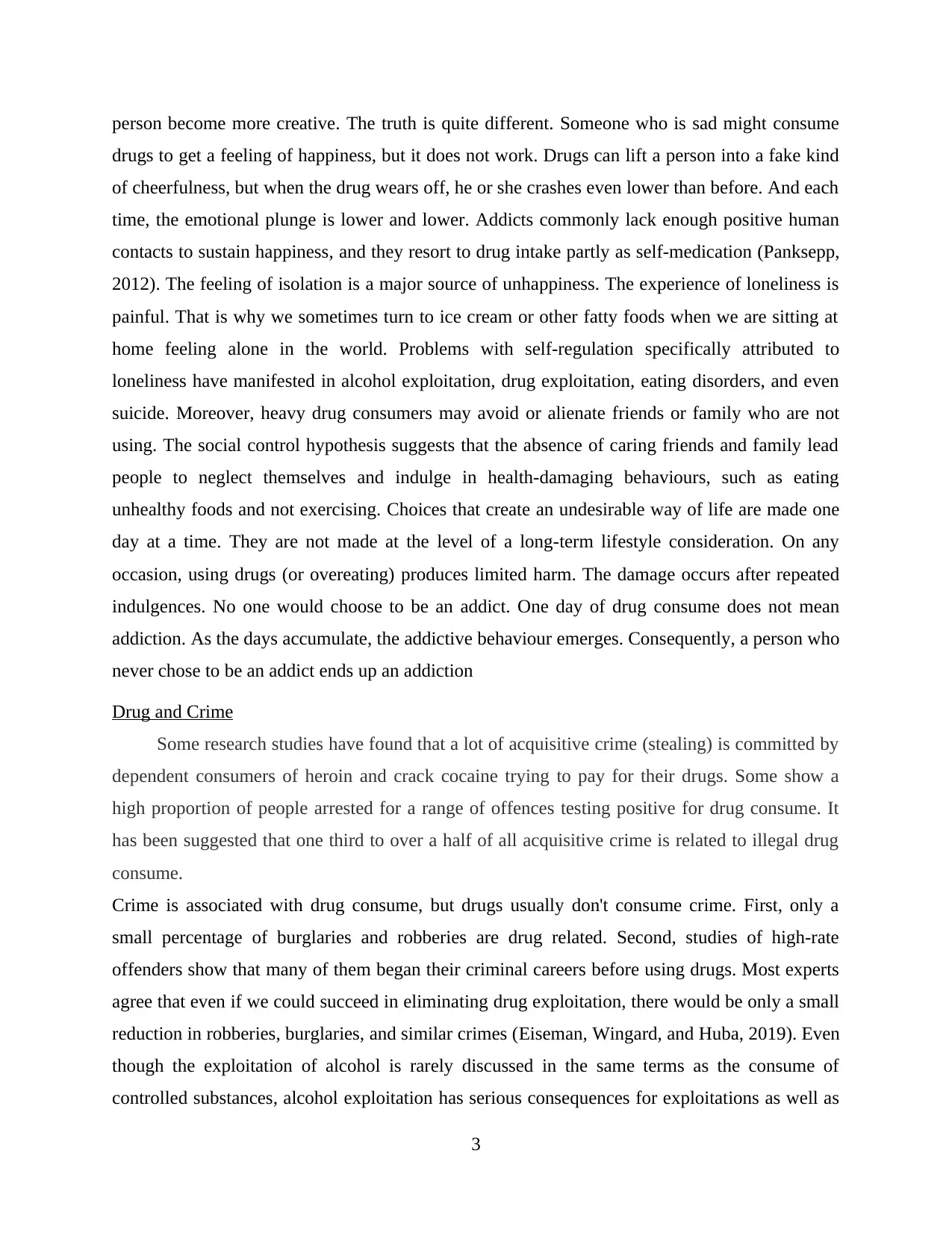
person become more creative. The truth is quite different. Someone who is sad might consume
drugs to get a feeling of happiness, but it does not work. Drugs can lift a person into a fake kind
of cheerfulness, but when the drug wears off, he or she crashes even lower than before. And each
time, the emotional plunge is lower and lower. Addicts commonly lack enough positive human
contacts to sustain happiness, and they resort to drug intake partly as self-medication (Panksepp,
2012). The feeling of isolation is a major source of unhappiness. The experience of loneliness is
painful. That is why we sometimes turn to ice cream or other fatty foods when we are sitting at
home feeling alone in the world. Problems with self-regulation specifically attributed to
loneliness have manifested in alcohol exploitation, drug exploitation, eating disorders, and even
suicide. Moreover, heavy drug consumers may avoid or alienate friends or family who are not
using. The social control hypothesis suggests that the absence of caring friends and family lead
people to neglect themselves and indulge in health-damaging behaviours, such as eating
unhealthy foods and not exercising. Choices that create an undesirable way of life are made one
day at a time. They are not made at the level of a long-term lifestyle consideration. On any
occasion, using drugs (or overeating) produces limited harm. The damage occurs after repeated
indulgences. No one would choose to be an addict. One day of drug consume does not mean
addiction. As the days accumulate, the addictive behaviour emerges. Consequently, a person who
never chose to be an addict ends up an addiction
Drug and Crime
Some research studies have found that a lot of acquisitive crime (stealing) is committed by
dependent consumers of heroin and crack cocaine trying to pay for their drugs. Some show a
high proportion of people arrested for a range of offences testing positive for drug consume. It
has been suggested that one third to over a half of all acquisitive crime is related to illegal drug
consume.
Crime is associated with drug consume, but drugs usually don't consume crime. First, only a
small percentage of burglaries and robberies are drug related. Second, studies of high‐rate
offenders show that many of them began their criminal careers before using drugs. Most experts
agree that even if we could succeed in eliminating drug exploitation, there would be only a small
reduction in robberies, burglaries, and similar crimes (Eiseman, Wingard, and Huba, 2019). Even
though the exploitation of alcohol is rarely discussed in the same terms as the consume of
controlled substances, alcohol exploitation has serious consequences for exploitations as well as
3
drugs to get a feeling of happiness, but it does not work. Drugs can lift a person into a fake kind
of cheerfulness, but when the drug wears off, he or she crashes even lower than before. And each
time, the emotional plunge is lower and lower. Addicts commonly lack enough positive human
contacts to sustain happiness, and they resort to drug intake partly as self-medication (Panksepp,
2012). The feeling of isolation is a major source of unhappiness. The experience of loneliness is
painful. That is why we sometimes turn to ice cream or other fatty foods when we are sitting at
home feeling alone in the world. Problems with self-regulation specifically attributed to
loneliness have manifested in alcohol exploitation, drug exploitation, eating disorders, and even
suicide. Moreover, heavy drug consumers may avoid or alienate friends or family who are not
using. The social control hypothesis suggests that the absence of caring friends and family lead
people to neglect themselves and indulge in health-damaging behaviours, such as eating
unhealthy foods and not exercising. Choices that create an undesirable way of life are made one
day at a time. They are not made at the level of a long-term lifestyle consideration. On any
occasion, using drugs (or overeating) produces limited harm. The damage occurs after repeated
indulgences. No one would choose to be an addict. One day of drug consume does not mean
addiction. As the days accumulate, the addictive behaviour emerges. Consequently, a person who
never chose to be an addict ends up an addiction
Drug and Crime
Some research studies have found that a lot of acquisitive crime (stealing) is committed by
dependent consumers of heroin and crack cocaine trying to pay for their drugs. Some show a
high proportion of people arrested for a range of offences testing positive for drug consume. It
has been suggested that one third to over a half of all acquisitive crime is related to illegal drug
consume.
Crime is associated with drug consume, but drugs usually don't consume crime. First, only a
small percentage of burglaries and robberies are drug related. Second, studies of high‐rate
offenders show that many of them began their criminal careers before using drugs. Most experts
agree that even if we could succeed in eliminating drug exploitation, there would be only a small
reduction in robberies, burglaries, and similar crimes (Eiseman, Wingard, and Huba, 2019). Even
though the exploitation of alcohol is rarely discussed in the same terms as the consume of
controlled substances, alcohol exploitation has serious consequences for exploitations as well as
3
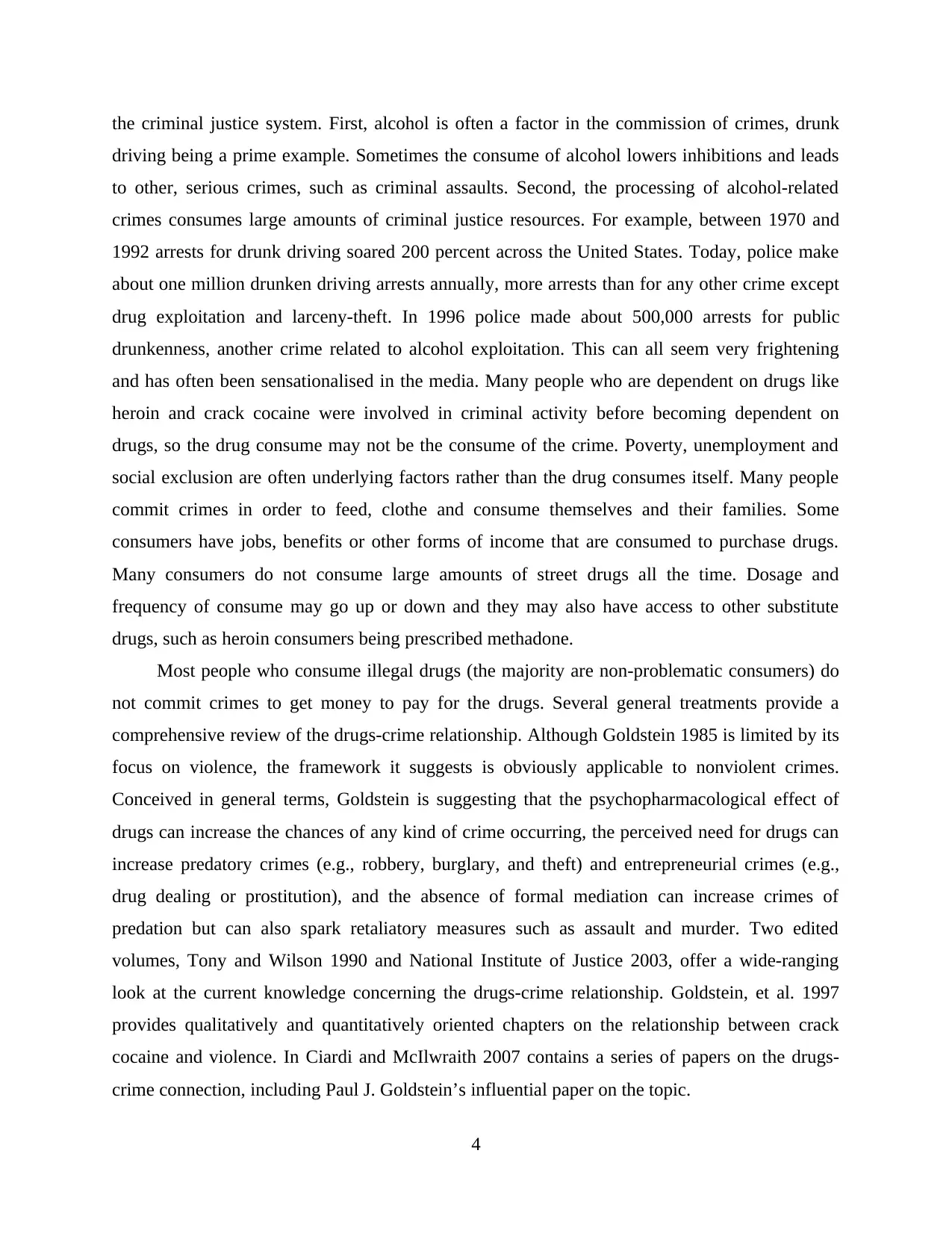
the criminal justice system. First, alcohol is often a factor in the commission of crimes, drunk
driving being a prime example. Sometimes the consume of alcohol lowers inhibitions and leads
to other, serious crimes, such as criminal assaults. Second, the processing of alcohol‐related
crimes consumes large amounts of criminal justice resources. For example, between 1970 and
1992 arrests for drunk driving soared 200 percent across the United States. Today, police make
about one million drunken driving arrests annually, more arrests than for any other crime except
drug exploitation and larceny‐theft. In 1996 police made about 500,000 arrests for public
drunkenness, another crime related to alcohol exploitation. This can all seem very frightening
and has often been sensationalised in the media. Many people who are dependent on drugs like
heroin and crack cocaine were involved in criminal activity before becoming dependent on
drugs, so the drug consume may not be the consume of the crime. Poverty, unemployment and
social exclusion are often underlying factors rather than the drug consumes itself. Many people
commit crimes in order to feed, clothe and consume themselves and their families. Some
consumers have jobs, benefits or other forms of income that are consumed to purchase drugs.
Many consumers do not consume large amounts of street drugs all the time. Dosage and
frequency of consume may go up or down and they may also have access to other substitute
drugs, such as heroin consumers being prescribed methadone.
Most people who consume illegal drugs (the majority are non-problematic consumers) do
not commit crimes to get money to pay for the drugs. Several general treatments provide a
comprehensive review of the drugs-crime relationship. Although Goldstein 1985 is limited by its
focus on violence, the framework it suggests is obviously applicable to nonviolent crimes.
Conceived in general terms, Goldstein is suggesting that the psychopharmacological effect of
drugs can increase the chances of any kind of crime occurring, the perceived need for drugs can
increase predatory crimes (e.g., robbery, burglary, and theft) and entrepreneurial crimes (e.g.,
drug dealing or prostitution), and the absence of formal mediation can increase crimes of
predation but can also spark retaliatory measures such as assault and murder. Two edited
volumes, Tony and Wilson 1990 and National Institute of Justice 2003, offer a wide-ranging
look at the current knowledge concerning the drugs-crime relationship. Goldstein, et al. 1997
provides qualitatively and quantitatively oriented chapters on the relationship between crack
cocaine and violence. In Ciardi and McIlwraith 2007 contains a series of papers on the drugs-
crime connection, including Paul J. Goldstein’s influential paper on the topic.
4
driving being a prime example. Sometimes the consume of alcohol lowers inhibitions and leads
to other, serious crimes, such as criminal assaults. Second, the processing of alcohol‐related
crimes consumes large amounts of criminal justice resources. For example, between 1970 and
1992 arrests for drunk driving soared 200 percent across the United States. Today, police make
about one million drunken driving arrests annually, more arrests than for any other crime except
drug exploitation and larceny‐theft. In 1996 police made about 500,000 arrests for public
drunkenness, another crime related to alcohol exploitation. This can all seem very frightening
and has often been sensationalised in the media. Many people who are dependent on drugs like
heroin and crack cocaine were involved in criminal activity before becoming dependent on
drugs, so the drug consume may not be the consume of the crime. Poverty, unemployment and
social exclusion are often underlying factors rather than the drug consumes itself. Many people
commit crimes in order to feed, clothe and consume themselves and their families. Some
consumers have jobs, benefits or other forms of income that are consumed to purchase drugs.
Many consumers do not consume large amounts of street drugs all the time. Dosage and
frequency of consume may go up or down and they may also have access to other substitute
drugs, such as heroin consumers being prescribed methadone.
Most people who consume illegal drugs (the majority are non-problematic consumers) do
not commit crimes to get money to pay for the drugs. Several general treatments provide a
comprehensive review of the drugs-crime relationship. Although Goldstein 1985 is limited by its
focus on violence, the framework it suggests is obviously applicable to nonviolent crimes.
Conceived in general terms, Goldstein is suggesting that the psychopharmacological effect of
drugs can increase the chances of any kind of crime occurring, the perceived need for drugs can
increase predatory crimes (e.g., robbery, burglary, and theft) and entrepreneurial crimes (e.g.,
drug dealing or prostitution), and the absence of formal mediation can increase crimes of
predation but can also spark retaliatory measures such as assault and murder. Two edited
volumes, Tony and Wilson 1990 and National Institute of Justice 2003, offer a wide-ranging
look at the current knowledge concerning the drugs-crime relationship. Goldstein, et al. 1997
provides qualitatively and quantitatively oriented chapters on the relationship between crack
cocaine and violence. In Ciardi and McIlwraith 2007 contains a series of papers on the drugs-
crime connection, including Paul J. Goldstein’s influential paper on the topic.
4
⊘ This is a preview!⊘
Do you want full access?
Subscribe today to unlock all pages.

Trusted by 1+ million students worldwide
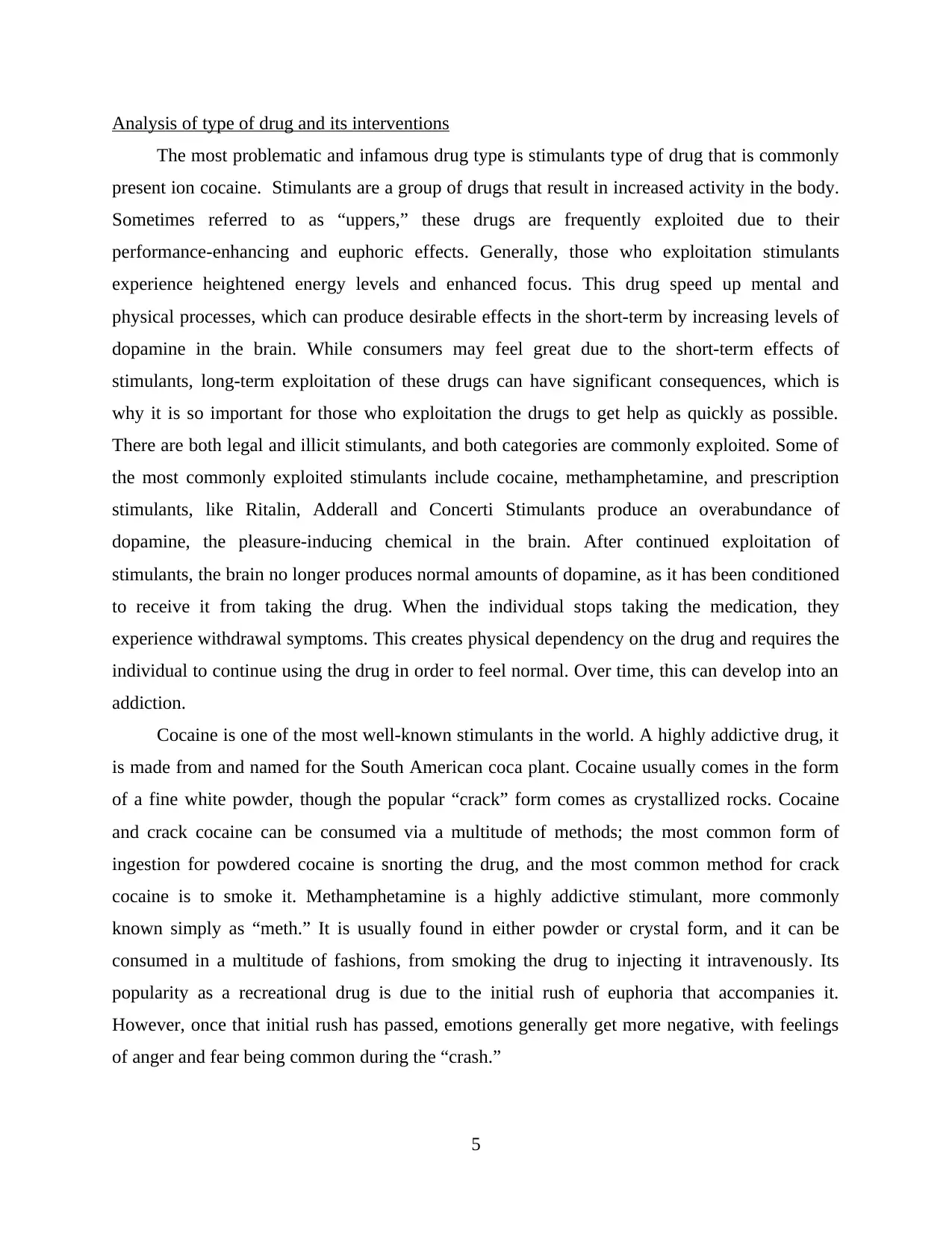
Analysis of type of drug and its interventions
The most problematic and infamous drug type is stimulants type of drug that is commonly
present ion cocaine. Stimulants are a group of drugs that result in increased activity in the body.
Sometimes referred to as “uppers,” these drugs are frequently exploited due to their
performance-enhancing and euphoric effects. Generally, those who exploitation stimulants
experience heightened energy levels and enhanced focus. This drug speed up mental and
physical processes, which can produce desirable effects in the short-term by increasing levels of
dopamine in the brain. While consumers may feel great due to the short-term effects of
stimulants, long-term exploitation of these drugs can have significant consequences, which is
why it is so important for those who exploitation the drugs to get help as quickly as possible.
There are both legal and illicit stimulants, and both categories are commonly exploited. Some of
the most commonly exploited stimulants include cocaine, methamphetamine, and prescription
stimulants, like Ritalin, Adderall and Concerti Stimulants produce an overabundance of
dopamine, the pleasure-inducing chemical in the brain. After continued exploitation of
stimulants, the brain no longer produces normal amounts of dopamine, as it has been conditioned
to receive it from taking the drug. When the individual stops taking the medication, they
experience withdrawal symptoms. This creates physical dependency on the drug and requires the
individual to continue using the drug in order to feel normal. Over time, this can develop into an
addiction.
Cocaine is one of the most well-known stimulants in the world. A highly addictive drug, it
is made from and named for the South American coca plant. Cocaine usually comes in the form
of a fine white powder, though the popular “crack” form comes as crystallized rocks. Cocaine
and crack cocaine can be consumed via a multitude of methods; the most common form of
ingestion for powdered cocaine is snorting the drug, and the most common method for crack
cocaine is to smoke it. Methamphetamine is a highly addictive stimulant, more commonly
known simply as “meth.” It is usually found in either powder or crystal form, and it can be
consumed in a multitude of fashions, from smoking the drug to injecting it intravenously. Its
popularity as a recreational drug is due to the initial rush of euphoria that accompanies it.
However, once that initial rush has passed, emotions generally get more negative, with feelings
of anger and fear being common during the “crash.”
5
The most problematic and infamous drug type is stimulants type of drug that is commonly
present ion cocaine. Stimulants are a group of drugs that result in increased activity in the body.
Sometimes referred to as “uppers,” these drugs are frequently exploited due to their
performance-enhancing and euphoric effects. Generally, those who exploitation stimulants
experience heightened energy levels and enhanced focus. This drug speed up mental and
physical processes, which can produce desirable effects in the short-term by increasing levels of
dopamine in the brain. While consumers may feel great due to the short-term effects of
stimulants, long-term exploitation of these drugs can have significant consequences, which is
why it is so important for those who exploitation the drugs to get help as quickly as possible.
There are both legal and illicit stimulants, and both categories are commonly exploited. Some of
the most commonly exploited stimulants include cocaine, methamphetamine, and prescription
stimulants, like Ritalin, Adderall and Concerti Stimulants produce an overabundance of
dopamine, the pleasure-inducing chemical in the brain. After continued exploitation of
stimulants, the brain no longer produces normal amounts of dopamine, as it has been conditioned
to receive it from taking the drug. When the individual stops taking the medication, they
experience withdrawal symptoms. This creates physical dependency on the drug and requires the
individual to continue using the drug in order to feel normal. Over time, this can develop into an
addiction.
Cocaine is one of the most well-known stimulants in the world. A highly addictive drug, it
is made from and named for the South American coca plant. Cocaine usually comes in the form
of a fine white powder, though the popular “crack” form comes as crystallized rocks. Cocaine
and crack cocaine can be consumed via a multitude of methods; the most common form of
ingestion for powdered cocaine is snorting the drug, and the most common method for crack
cocaine is to smoke it. Methamphetamine is a highly addictive stimulant, more commonly
known simply as “meth.” It is usually found in either powder or crystal form, and it can be
consumed in a multitude of fashions, from smoking the drug to injecting it intravenously. Its
popularity as a recreational drug is due to the initial rush of euphoria that accompanies it.
However, once that initial rush has passed, emotions generally get more negative, with feelings
of anger and fear being common during the “crash.”
5
Paraphrase This Document
Need a fresh take? Get an instant paraphrase of this document with our AI Paraphraser
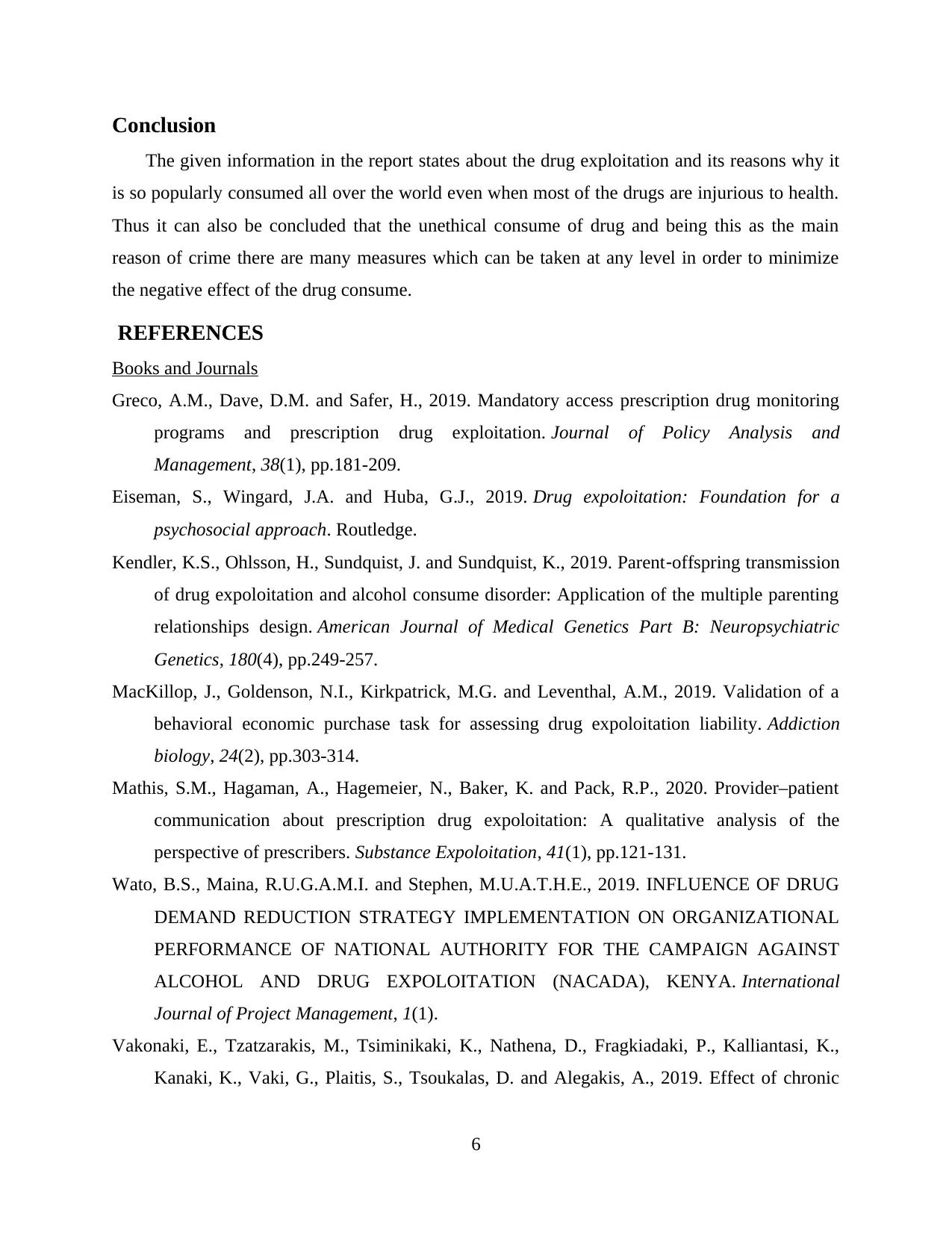
Conclusion
The given information in the report states about the drug exploitation and its reasons why it
is so popularly consumed all over the world even when most of the drugs are injurious to health.
Thus it can also be concluded that the unethical consume of drug and being this as the main
reason of crime there are many measures which can be taken at any level in order to minimize
the negative effect of the drug consume.
REFERENCES
Books and Journals
Greco, A.M., Dave, D.M. and Safer, H., 2019. Mandatory access prescription drug monitoring
programs and prescription drug exploitation. Journal of Policy Analysis and
Management, 38(1), pp.181-209.
Eiseman, S., Wingard, J.A. and Huba, G.J., 2019. Drug expoloitation: Foundation for a
psychosocial approach. Routledge.
Kendler, K.S., Ohlsson, H., Sundquist, J. and Sundquist, K., 2019. Parent‐offspring transmission
of drug expoloitation and alcohol consume disorder: Application of the multiple parenting
relationships design. American Journal of Medical Genetics Part B: Neuropsychiatric
Genetics, 180(4), pp.249-257.
MacKillop, J., Goldenson, N.I., Kirkpatrick, M.G. and Leventhal, A.M., 2019. Validation of a
behavioral economic purchase task for assessing drug expoloitation liability. Addiction
biology, 24(2), pp.303-314.
Mathis, S.M., Hagaman, A., Hagemeier, N., Baker, K. and Pack, R.P., 2020. Provider–patient
communication about prescription drug expoloitation: A qualitative analysis of the
perspective of prescribers. Substance Expoloitation, 41(1), pp.121-131.
Wato, B.S., Maina, R.U.G.A.M.I. and Stephen, M.U.A.T.H.E., 2019. INFLUENCE OF DRUG
DEMAND REDUCTION STRATEGY IMPLEMENTATION ON ORGANIZATIONAL
PERFORMANCE OF NATIONAL AUTHORITY FOR THE CAMPAIGN AGAINST
ALCOHOL AND DRUG EXPOLOITATION (NACADA), KENYA. International
Journal of Project Management, 1(1).
Vakonaki, E., Tzatzarakis, M., Tsiminikaki, K., Nathena, D., Fragkiadaki, P., Kalliantasi, K.,
Kanaki, K., Vaki, G., Plaitis, S., Tsoukalas, D. and Alegakis, A., 2019. Effect of chronic
6
The given information in the report states about the drug exploitation and its reasons why it
is so popularly consumed all over the world even when most of the drugs are injurious to health.
Thus it can also be concluded that the unethical consume of drug and being this as the main
reason of crime there are many measures which can be taken at any level in order to minimize
the negative effect of the drug consume.
REFERENCES
Books and Journals
Greco, A.M., Dave, D.M. and Safer, H., 2019. Mandatory access prescription drug monitoring
programs and prescription drug exploitation. Journal of Policy Analysis and
Management, 38(1), pp.181-209.
Eiseman, S., Wingard, J.A. and Huba, G.J., 2019. Drug expoloitation: Foundation for a
psychosocial approach. Routledge.
Kendler, K.S., Ohlsson, H., Sundquist, J. and Sundquist, K., 2019. Parent‐offspring transmission
of drug expoloitation and alcohol consume disorder: Application of the multiple parenting
relationships design. American Journal of Medical Genetics Part B: Neuropsychiatric
Genetics, 180(4), pp.249-257.
MacKillop, J., Goldenson, N.I., Kirkpatrick, M.G. and Leventhal, A.M., 2019. Validation of a
behavioral economic purchase task for assessing drug expoloitation liability. Addiction
biology, 24(2), pp.303-314.
Mathis, S.M., Hagaman, A., Hagemeier, N., Baker, K. and Pack, R.P., 2020. Provider–patient
communication about prescription drug expoloitation: A qualitative analysis of the
perspective of prescribers. Substance Expoloitation, 41(1), pp.121-131.
Wato, B.S., Maina, R.U.G.A.M.I. and Stephen, M.U.A.T.H.E., 2019. INFLUENCE OF DRUG
DEMAND REDUCTION STRATEGY IMPLEMENTATION ON ORGANIZATIONAL
PERFORMANCE OF NATIONAL AUTHORITY FOR THE CAMPAIGN AGAINST
ALCOHOL AND DRUG EXPOLOITATION (NACADA), KENYA. International
Journal of Project Management, 1(1).
Vakonaki, E., Tzatzarakis, M., Tsiminikaki, K., Nathena, D., Fragkiadaki, P., Kalliantasi, K.,
Kanaki, K., Vaki, G., Plaitis, S., Tsoukalas, D. and Alegakis, A., 2019. Effect of chronic
6
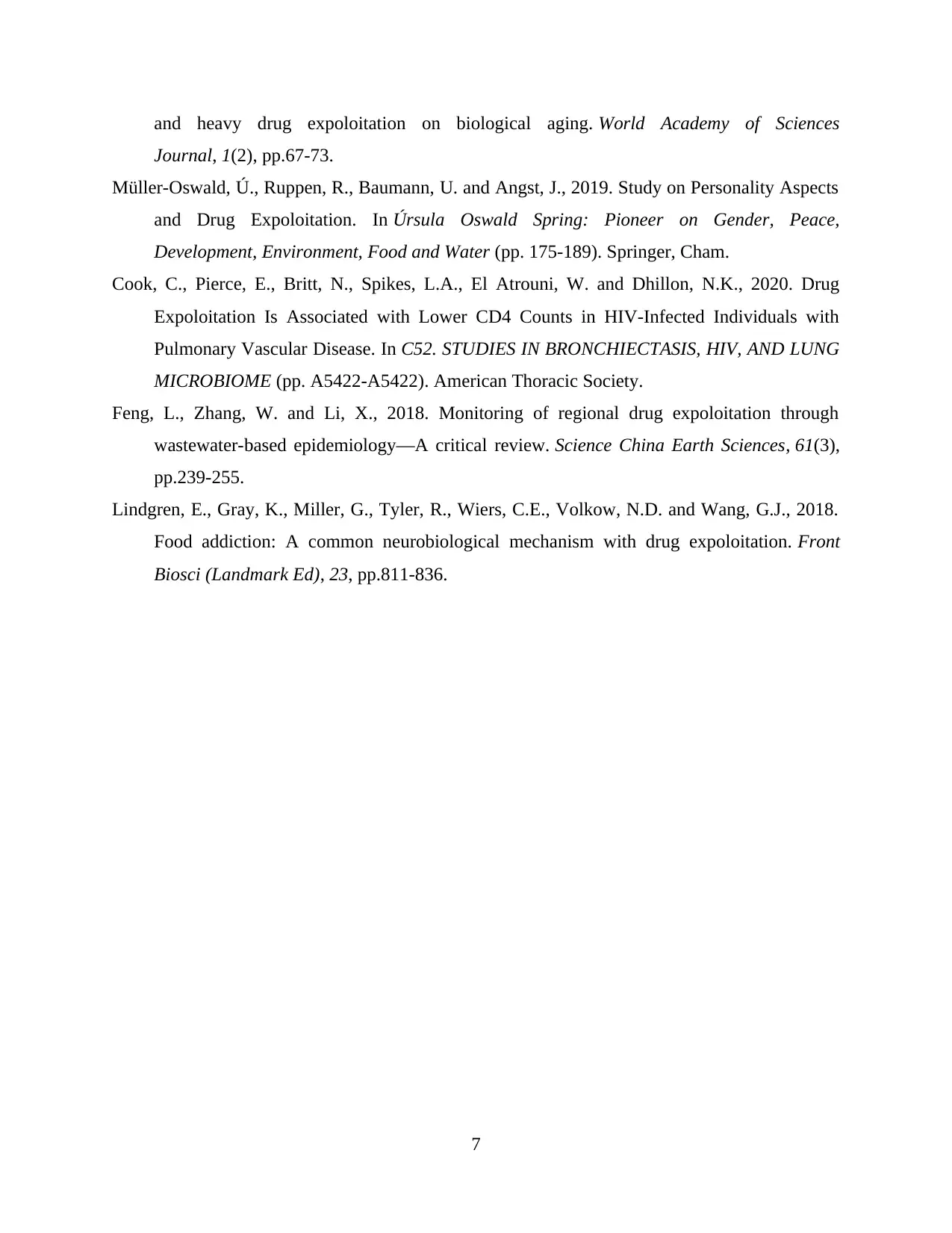
and heavy drug expoloitation on biological aging. World Academy of Sciences
Journal, 1(2), pp.67-73.
Müller-Oswald, Ú., Ruppen, R., Baumann, U. and Angst, J., 2019. Study on Personality Aspects
and Drug Expoloitation. In Úrsula Oswald Spring: Pioneer on Gender, Peace,
Development, Environment, Food and Water (pp. 175-189). Springer, Cham.
Cook, C., Pierce, E., Britt, N., Spikes, L.A., El Atrouni, W. and Dhillon, N.K., 2020. Drug
Expoloitation Is Associated with Lower CD4 Counts in HIV-Infected Individuals with
Pulmonary Vascular Disease. In C52. STUDIES IN BRONCHIECTASIS, HIV, AND LUNG
MICROBIOME (pp. A5422-A5422). American Thoracic Society.
Feng, L., Zhang, W. and Li, X., 2018. Monitoring of regional drug expoloitation through
wastewater-based epidemiology—A critical review. Science China Earth Sciences, 61(3),
pp.239-255.
Lindgren, E., Gray, K., Miller, G., Tyler, R., Wiers, C.E., Volkow, N.D. and Wang, G.J., 2018.
Food addiction: A common neurobiological mechanism with drug expoloitation. Front
Biosci (Landmark Ed), 23, pp.811-836.
7
Journal, 1(2), pp.67-73.
Müller-Oswald, Ú., Ruppen, R., Baumann, U. and Angst, J., 2019. Study on Personality Aspects
and Drug Expoloitation. In Úrsula Oswald Spring: Pioneer on Gender, Peace,
Development, Environment, Food and Water (pp. 175-189). Springer, Cham.
Cook, C., Pierce, E., Britt, N., Spikes, L.A., El Atrouni, W. and Dhillon, N.K., 2020. Drug
Expoloitation Is Associated with Lower CD4 Counts in HIV-Infected Individuals with
Pulmonary Vascular Disease. In C52. STUDIES IN BRONCHIECTASIS, HIV, AND LUNG
MICROBIOME (pp. A5422-A5422). American Thoracic Society.
Feng, L., Zhang, W. and Li, X., 2018. Monitoring of regional drug expoloitation through
wastewater-based epidemiology—A critical review. Science China Earth Sciences, 61(3),
pp.239-255.
Lindgren, E., Gray, K., Miller, G., Tyler, R., Wiers, C.E., Volkow, N.D. and Wang, G.J., 2018.
Food addiction: A common neurobiological mechanism with drug expoloitation. Front
Biosci (Landmark Ed), 23, pp.811-836.
7
⊘ This is a preview!⊘
Do you want full access?
Subscribe today to unlock all pages.

Trusted by 1+ million students worldwide
1 out of 9
Related Documents
Your All-in-One AI-Powered Toolkit for Academic Success.
+13062052269
info@desklib.com
Available 24*7 on WhatsApp / Email
![[object Object]](/_next/static/media/star-bottom.7253800d.svg)
Unlock your academic potential
Copyright © 2020–2025 A2Z Services. All Rights Reserved. Developed and managed by ZUCOL.



